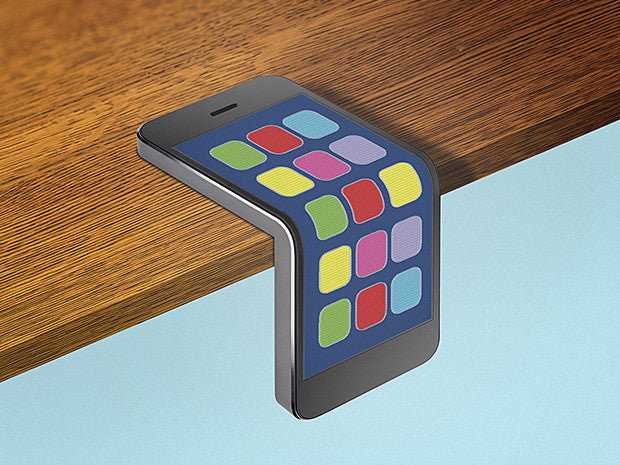
"The rumours have been swirling for months. Though they couldn’t be confirmed, their persistence suggests that something significant may be coming from Samsung, possibly as early as this year: a foldable mobile.
Today, the world of mobiles consists of two major realms—tablets and smartphones. Tablets are good for reading magazines and books, typing long messages on a linked keyboard, looking at pictures, and surfing the Web. Smartphones are good for texting and talking. Engineers have long dreamed of merging the two.
Such a device would morph from one to the other by folding: Open, it’s a tablet, but by bending or folding it in half you’d transform it into a phone. “You can expect to open up your phone and double the screen real estate,” says Roel Vertegaal, a computer scientist at Queen’s University in Ontario. Besides the versatility, you’d have interesting new possibilities—imagine bending your phone to flip ahead in an e-book, just as you would flex a novel’s covers to jump ahead a few pages.
Samsung has pursued flexible designs for at least four years, going so far as to develop “artificial muscles” that push and pull a smartphone’s components into new positions to prevent damage as it bends. Now, according to media reports, the company may finally be ready to share those technologies with the world and save users the hassle of carrying both a phone and a tablet.
“Having that bimodality in a device would, I think, be really game changing,” says mobile analyst Wayne Lam at IHS Markit. “You’re not only creating a new form factor for the phone, but you’re also cannibalising other product categories.”
Competitors are thinking along similar elastic lines. At a trade show last summer, Lenovo showed off a concept product for a smartphone that folded around a user’s wrist into a wearable device. Throughout 2016, a Chinese manufacturer named Moxi Group promised a limited release of its own high end flexible smartphone. But Samsung would be the first of any major company to debut a device with a truly flexible screen.
If Samsung does release such a phone, it would signal the first major departure from the flat, rectangular form that has defined smartphone designs since Apple released the first iPhone in 2007. Manufacturers have experimented with curved glass and adopted larger screens, but essentially all smartphones today are design descendants of that original iPhone.
The simple, rigid smartphone has endured partly because the challenges of building a foldable screen that is rugged and dependable are great. Stiff components such as the battery must be made to either bend along with the screen or be situated away from the fold.
Vertegaal himself built a flexible smartphone in his lab last year and tested hundreds of screens before settling on one that worked—a high-definition organic light-emitting-diode screen produced by LG Display. OLED screens contain a thin film of organic compounds that produce light from an electric current right at the surface of the device. They are a favorite of designers working on flexible TV and mobile units because they do not require the bulky backlight and filters found in LCD screens.
Samsung happens to be the largest global supplier of OLED panels. In 2013, the company showed off a concept product with a bendable OLED screen at the CES electronics show. It set off a frenzy in the tech blogosphere and led to speculation that the company would release a smartphone based on it. "

"Vertegaal says the biggest challenge in building his own flexible phone was powering all the pixels in his LG display with connectors that could withstand repeated bendings. To keep it simple, he used a relatively primitive screen that had only 720 pixels. He realised that the rigid materials found in conventional smartphones are, unfortunately, quite delicate. “Circuits are made out of metals, and these metals break under stress,” he says. “While it’s possible to make these bendable screens, it’s difficult to make them in a way that they don’t break.”
One solution may be to use printed electronics to integrate razor-thin circuits and flattened antennas along the surfaces of a smartphone. In theory, this technique could make phones more flexible by reducing the number of large components and fragile attachments within the device. However, the easiest way to create such products is with injection moulding, a process that is seldom used in smartphone manufacturing.
Right now, only two companies in the world have the expertise and production chops to manufacture a smartphone with a bendable display for the mass market: Samsung and LG, says William Stofega, a mobile analyst at International Data Corp. Just last year, at CES, LG exhibited an OLED screen, less than 1 millimetre thick, that could roll up like a newspaper. But Stofega says the time, complexity, and expense of manufacturing means that any flexible products that debut this year will likely be pricey, high-end devices.
Samsung needs a hit to regain momentum after last year’s Galaxy Note 7 fiasco, in which it coped with reports of dozens of the smartphones catching fire. Ultimately, the problems prompted a recall that slashed profits by 17 percent, or US $4 billion, in that quarter. A flashy line of foldable phones could help the company rebuild its reputation. However, it would be a high-risk strategy, Stofega notes. “No one wants to risk coming out with a device that looks pretty cool and then, after about 2,000 bends, just cracks right in half,” he says.
Samsung wouldn’t comment on its plans for 2017. So we’ll all have to wait and see if the company dazzles us this year with a couple of flexible smartphones—or leaves the many design headaches and teething pains for its rivals to endure. "
Source: Amy Nordrum, www.spectrum.ieee.org

